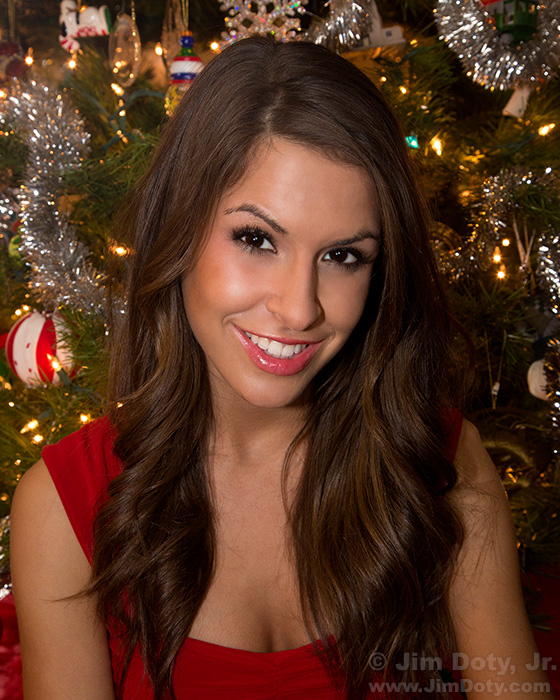On Christmas eve I found myself doing Christmas portraits for a friend’s portfolio (she is an agency represented model). There isn’t a lot of space in our living room when the Christmas tree is up so I had to improvise a bit with the lighting and I needed to get the right mix of flash and ambient light for the look I wanted.
I used a studio flash with an umbrella (camera left) as the “main” light. Studio flash units are manual only with a slider or other control to change the power output to match the aperture you want to use. I triggered the slave on the studio flash with an on-camera flash which was the “fill” light. It was in manual mode with the power dialed down.
My preferred aperture was f/8 to give me enough depth of field for Kristina’s face but leave the tree slightly blurred but clearly recognizable.
My preference when using a studio flash is to set the camera ISO to 100 for maximum image quality, and use a fast shutter speed. For this photo I needed to “drag the shutter” (use a long shutter speed to record the ambient light) to record the lights on the Christmas tree. Even with a shutter speed of 1/60 second at ISO 100, the Christmas lights would barely show up and the tree would look too dark
At ISO 100 with an aperture of f/8, the correct shutter speed to record the Christmas tree they way I wanted turned out to be 1 second. I rarely ask anyone to remain totally motionless for 1 second unless I want some ghosting from subject motion, so I boosted the ISO to 800, giving me an ambient light shutter speed of 1/8 second for the tree. At that shutter speed there is minimal chance of subject ghosting in a portrait shoot provided you ask the subject not to move after the flash fires. At 1/8 second it is best if the camera is on a tripod.
When using manual flash, whether off camera or on camera, the fastest and most accurate approach is to use an incident light meter. An alternative is to do some test shots, paying careful attention to the histogram. Do not trust the LCD image on the back of your camera to give you a truly accurate exposure.
Photo Data: Canon EOS 5D Mark III on a Gitzo tripod. Canon EF24-105mm f/4L IS USM lens at 50 mm. Canon 550 EX flash on camera in manual mode. Alien Bees studio flash with an umbrella.
Links
In my book Digital Photography Exposure for Dummies you can learn all about portraits, depth of field, using an on-camera flash in manual mode, using studio lights, balancing main and fill lights for the lighting ratio you want, metering with an incident light meter, using a histogram to check exposure, and mixing flash with ambient light. Digital Photography Exposure for Dummies is one of the highest rated photography books at Amazon.com. You can learn more here and order it at Amazon.com.

